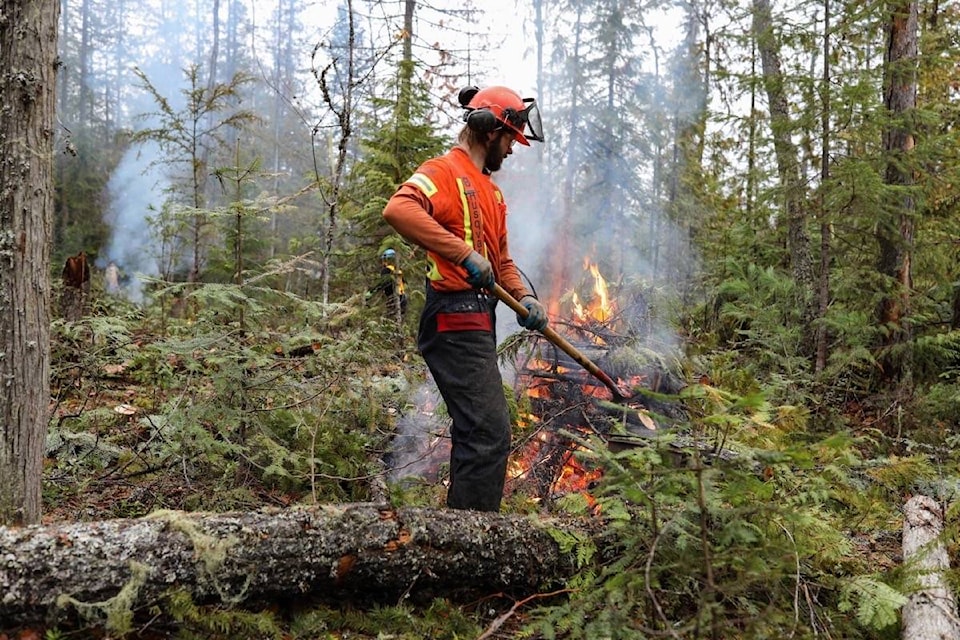Wildfire fuel treatment work has been ramped up this year in forests in the Nelson area.
And none too soon. In 2016, wildfire expert Bruce Blackwell told city council, “Nelson is in my top ten towns in B.C. and Alberta for wildfire danger. I would have classified Fort McMurray as low to moderate risk. Nelson faces a far greater risk.”
Of course the risk doesn’t just exist in the city but also in the homes and forested lands in the surrounding area.
In the rural area stretching along the West Arm from Glade to Howser, the Regional District of Central Kootenay has received funding to write prescriptions for the treatment of about 1000 hectares of forest land in the next year.
That’s a big jump from the total of 500 hectares of work completed by the RDCK in the past ten years, according to John Cathro, a forest consultant who is currently the project manger for treatment work the Regional District tendered in 2017.
A prescription is a written plan for creating fuel breaks. At the RDCK this typically means working by hand, modifying forest vegetation by retaining large dominant trees, thinning and removing small trees, removing deadfall, pruning the lower parts of the retained trees, and burning everything removed.
After the prescriptions are written this year the RDCK then has to apply for funding again to hire workers to do the actual work next year.
Funding for some projects comes 100 per cent from the Forest Enhancement Society of B.C., a fund set up by the provincial government in 2016. Other projects get 75 per cent provincial money through the Union of B.C. Municipalities, with the remainder of funding coming from local government and Columbia Basin Trust .
The work can cost about $10,000 per hectare if there is no merchantable timber, but the generally accepted goal is to make it cost-neutral by selling timber from the site.
Related stories in the Nelson Star:
• Action by Nelson area landowners key to wildfire safety, expert says (June 2016)
• Fire experts: Nelson could burn (Dec, 2016)
• RDCK plans wildfire fuel action (Aug. 2017)
• West Arm Park fire prevention plans move forward (Oct. 2017)
• Column: Will West Kootenay forests survive? (Nov. 2017)
• Fighting fire with fire (Nov. 2017)
Closer to Nelson, prescriptions have already been written for 400 hectares that need treatment in West Arm Park on both the Nelson and Harrop sides for work that will begin this fall, and prescriptions are being written for 200 hectares in the Selous Creek area.
And fuel treatment work is being completed now adjacent to the rail trail both north and south of Mountain Station.
In the Slocan Valley, the Slocan Integral Forestry Cooperative has just received a $1 million grant from the Forest Enhancement Society to continue implementing its strategic wildfire plan.
The cooperative’s Stephan Martineau told the Star about a 47 hectare project near New Denver, a re-treatment program in the Red Mountain area, post harvest fuel mitigation in the Hewitt Mine Road area, 16 hectares at the Bannock Point recreational site, and fuel treatment up the Ponderosa forest service road followed by a prescribed burn there next year.
He added that the group is also treating fuel within the Village of Slocan boundaries and along the Slocan rail trail.
“There is a growing awareness,” says Cathro, “among different levels of government and among residents that we need to manage the land differently and we need to be prioritizing protection of our communities. Appropriate forest management is a big part of that. So now there is funding coming to the table and there is an exponential growth in the amount of area being treated to reduce the hazard.”
bill.metcalfe@nelsonstar.com
Like us on Facebook and follow us on Twitter
